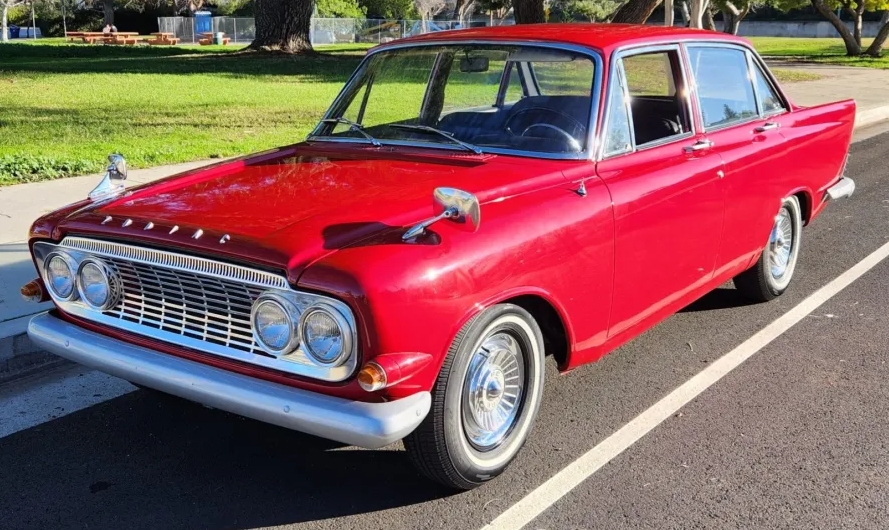The Gilded Barge: Charting the Aspirational Evolution of the Ford Zodiac
In the landscape of post-war Britain, a nation emerging from the grey austerity of rationing and reconstruction, the Ford Zodiac was more than just a car. It was a technicolor dream, a slice of American glamour made accessible to the successful British manager, doctor, or businessman. For nearly two decades, the Zodiac nameplate represented the pinnacle of Ford’s British offerings, a symbol of attainable luxury that mirrored the country’s own journey from stoic recovery to the exuberant consumerism of the Swinging Sixties. Its evolution, through four distinct marks, is a fascinating story of changing tastes, engineering progress, and the relentless pursuit of status.
The Genesis: Zodiac Mark I (1953 – 1956)
The Zodiac story begins not as a standalone model, but as the ultimate trim level. In 1950, Ford of Britain launched its revolutionary “Three Graces”: the four-cylinder Consul and the six-cylinder Zephyr. These cars, with their monocoque construction, MacPherson strut front suspension, and overhead-valve engines, were a world away from the pre-war designs they replaced. They were modern, stylish, and hugely successful.
Ford, however, correctly identified a niche above the already well-appointed Zephyr Six. At the 1953 London Motor Show, they unveiled the Ford Zodiac (EOT-series). It wasn’t a new car, but rather a Zephyr Six that had been given a comprehensive luxury makeover by the coachbuilder Briggs. The Zodiac was conceived as a halo model, designed to attract customers who might otherwise have looked towards a Humber or a Rover.
Mechanically, it was identical to the Zephyr, powered by the same 2,262 cc straight-six engine producing a modest 68 horsepower, mated to a three-speed, column-shift manual gearbox. The difference was entirely in the presentation. The Zodiac was immediately identifiable by its signature two-tone paint schemes—options like Dorchester Grey over Canterbury Green or Bristol Fawn over Corfe Grey became iconic. It came lavished with features that were costly extras on lesser cars: leather upholstery, a heater and windscreen washers as standard, whitewall tyres, chrome wheel trims, and a pair of elegant Lucas spot lamps flanking the grille. Inside, the driver was greeted with a plusher environment, a clock, and a sense of occasion.
The Mark I Zodiac was a statement. It declared that its owner had arrived. While its performance was respectable, with a top speed cresting 80 mph, its true purpose was to cruise with an air of effortless superiority. Although official production was limited to the saloon, specialist coachbuilders like Carbodies and E.D. Abbott of Farnham produced a small number of desirable convertible and estate versions, respectively. In its three-year production run, the Mark I established the Zodiac name as a byword for affordable British luxury.
Peak Americana: Zodiac Mark II (1956 – 1962)
If the Mark I was a toe in the water of transatlantic styling, the Mark II was a full-blooded cannonball dive. Launched in 1956, the new Zodiac (now designated the 206E) was a complete redesign. It was longer, lower, and wider, dripping with the design language of mid-50s Detroit. Sharp, prominent tailfins sliced through the air, acres of chrome adorned the bodywork, and wrap-around front and rear windscreens gave the cabin an airy, panoramic feel.
This was the Zodiac at its most flamboyant and, for many, its most memorable. Under the bonnet, the straight-six engine was enlarged to 2,553 cc, boosting power to a healthier 86 horsepower. This gave the larger car a genuine turn of speed, capable of reaching a top speed close to 90 mph.
The Mark II Zodiac was again the top-tier model, sitting above the new Consul Mark II and Zephyr Mark II. Its exclusive features were more pronounced than ever. It boasted elaborate two-tone paint jobs, gold-plated “Zodiac” badges and bonnet ornament, and an interior that was a symphony of leather, chrome, and high-quality vinyl. The dashboard was a work of art, with a full set of instruments housed in a stylish binnacle.
During its production life, the Mark II saw several key developments. Early models are known by enthusiasts as the “Highline” due to their taller roof profile. In 1959, the roofline was lowered and the rear window enlarged, creating the sleeker “Lowline” model. More significant were the mechanical upgrades: front disc brakes became standard in 1960, and a Borg-Warner three-speed automatic transmission became a popular optional extra from 1956, cementing the Zodiac’s appeal as a comfortable, effortless cruiser. The Abbott estate conversion remained available for the discerning country gentleman, creating a vehicle of immense practicality and style. The Mark II was a resounding commercial success, perfectly capturing the optimistic, aspirational mood of late 1950s Britain.
Crisp Modernism: Zodiac Mark III (1962 – 1966)
As the 1960s dawned, the rococo excesses of 1950s car design began to look dated. The Zodiac Mark III (213E), launched in 1962, represented a dramatic stylistic shift. The fins and voluptuous curves were gone, replaced by a crisp, sharp, and sophisticated design penned by Canadian Roy Brown Jr., ironically the same man who had designed the infamous Ford Edsel.
The Mark III had a unique and assertive look. Its most distinctive features were its quad-headlight front end and a reverse-rake rear window, a design cue borrowed from the smaller Ford Anglia that gave it a formal, limousine-like roofline. The body featured a subtle “arrow” profile, with clean, uninterrupted lines from front to back. It was a design that looked elegant and modern, moving away from American mimicry towards a more distinct, transatlantic identity.
While the wheelbase remained the same as the Mark II, the car was stronger and better engineered. The 2,553 cc six-cylinder engine was carried over but significantly reworked with a higher compression ratio and better breathing, now producing a potent 109 horsepower. Mated to a new, standard four-speed all-synchromesh manual gearbox (with optional Laycock de Normanville overdrive or automatic transmission), the Mark III was the first Zodiac capable of genuinely exceeding 100 mph.
Inside, the luxury was more refined. The traditional bench front seat was replaced by individual reclining seats, and the dashboard was a comprehensive affair with full instrumentation set into a wood veneer fascia. The Zodiac was once again the flagship, distinguished from its four-cylinder Zephyr 4 and six-cylinder Zephyr 6 siblings by its quad headlights, more luxurious trim, extra chrome detailing, and superior standard equipment, which included a horn ring, reversing lights, and plush carpeting. It was a fast, comfortable, and thoroughly modern executive express, proving to be a favourite with police forces and company directors alike. The beautiful Abbott estate also continued to be offered for those needing more space without sacrificing prestige.
The Final Chapter: Zodiac Mark IV (1966 – 1972)
The fourth and final generation of the Zodiac, launched in 1966, was the most ambitious and ultimately the most controversial. The Mark IV (3012E) was a vast car, a true “land-yacht” that dwarfed its predecessors. Its styling was pure transatlantic bravado: a long, imposing bonnet, a short boot deck with a curious styling feature mimicking a spare wheel mount, and a vast, airy glasshouse.
The big news, however, was under the skin. The Mark IV and its Zephyr siblings moved to a much more sophisticated chassis featuring a brand-new V-engine family and, crucially, independent rear suspension. This was a radical step for a large, mass-produced British Ford and promised a new level of ride comfort and handling.
The Zodiac was powered by Ford’s new 3.0-litre (2,994 cc) “Essex” V6 engine, producing around 136 horsepower. This gave the big car effortless performance and a smooth, loping gait perfect for the new motorways spreading across Britain. Power steering and disc brakes on all four wheels were standard.
This generation also saw a significant change in the model hierarchy. For the first time, the Zodiac was not the absolute pinnacle. The range now comprised:
Zephyr V4: The base model with a 2.0-litre V4 engine.
Zephyr V6: The mid-range model with a 2.5-litre version of the Essex V6.
Zodiac V6: The luxury model, equipped with the 3.0-litre V6, four headlights, a more imposing grille, higher-grade interior trim, and extra instrumentation.
The Executive (from late 1966): This was the new range-topper. Essentially a Zodiac loaded with every conceivable extra, the Executive came with an automatic transmission and power steering as standard, a sliding steel sunroof, full leather upholstery, deep-pile carpeting, fog lamps, and a radio. It was Ford’s answer to cars like the Rover P5B and was aimed squarely at the top of the corporate ladder.
Despite its technical sophistication, the Mark IV was a flawed masterpiece. Its sheer size made it unwieldy on narrow British roads, and the early independent rear suspension’s V-arm design gave it notoriously wayward handling characteristics, especially in the wet. While comfortable on a straight road, it could be a handful in the corners, earning it the somewhat unfair nickname “The Barge.”
.
Many car aficionados have multiple hobbies, like boating as well as auto stuff. Those who don’t already own a boat (and even some that do), may have thought about building their own boats. It’s really not as hard as you’d think. Just take a look at these easy boat building plans!

.
The End of an Era
By the early 1970s, the world had changed. The 1973 oil crisis was looming, making large, thirsty cars like the Zodiac seem like dinosaurs. Tastes were shifting towards more compact, efficient, and sophisticated European saloons from brands like BMW and Mercedes-Benz. Furthermore, Ford’s own product line was evolving. The upmarket versions of the Cortina began to encroach on Zodiac territory from below, while the new, pan-European Ford Granada was being developed to replace the entire Zephyr/Zodiac range with a more modern and cohesive product.
In 1972, production of the Zodiac ceased. The nameplate that had defined affordable British luxury for 19 years was retired. The Ford Granada took its place, offering a similar blend of space and comfort but in a more modern, European package.
The Ford Zodiac’s legacy is indelible. It perfectly charted the social and economic trajectory of post-war Britain, evolving from a chromed-up saloon for the newly prosperous to a sophisticated, powerful executive cruiser. It offered a taste of the good life, a touch of Detroit glamour on British streets, and for a generation, it was the ultimate symbol of having made it.







